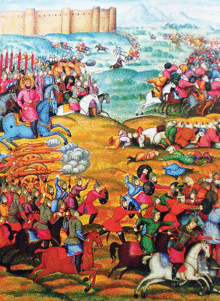Nader's Central Asian Campaign
| Nader Shah's Conquest of Central Asia | |||||||||
|---|---|---|---|---|---|---|---|---|---|
| Part of Nader's Campaigns | |||||||||
 Illustration of Nader's battle against Ilbares Khan |
|||||||||
|
|||||||||
| Belligerents | |||||||||
|
|
|
||||||||
| Commanders and leaders | |||||||||
|
Nader Shah Reza Qoli Mirza Tahmasp Jalayer |
|
||||||||
| Strength | |||||||||
| Unknown | 60,000+ | ||||||||
| Casualties and losses | |||||||||
| minimal | heavy | ||||||||
| The leaders in bold are sovereigns | |||||||||
Persian suzerainty over Central Asia:
During the mid-eighteenth century the Persian empire of Nader Shah embarked upon the conquest and annexation of the Khanates of Bukhara and Khiva . The initial engagements were fought in the late 1730s by Nader Shah's son and viceroy Reza Qoli Mirza who gained a few notable victories in this theatre while Nader was still invading India to the south. Reza Qoli's invasions of Khiva angered Ilbars khan, the leader of Khiva. When Ilbars threatened to make a counter-attack Nader ordered hostilities to cease despite his son's successes and later returned victoriously from Delhi to embark on a decisive campaign himself.
After annexing Khiva he executed Ilbars and replaced him with Abu ol-Fayz Kha, who Nader considered to be more accepting of Nader's overlordship. The conflict resulted in the most overwhelming Persian triumph against the khanates of Central Asia in modern history and with the admixture of his previous annexation in northern India, Nader's empire in the east surpassed all other Iranian empires before it, all the way back to the Sassanians and Achaemenids of antiquity.
In 1734-35 Ilbārs Khan sent a large party of Turkmens in a raid against Khorasan, where they plundered Čamešgezek Kurds in the regions of the Ālā Dāḡ mountain and Samalqān, but then were defeated by the Persian army. In 1737, when Reza Qoli Mirza Afshar, son of Nāder Shah and viceroy of the Empire, marched against Bukhara after having subdued the rulers of Balḵ and Andḵuy, Abu’l-Fayż Khan, the ruler of Bukhara, appealed for help to Ilbārs Khan, who set out to Transoxania with his army but turned back halfway, apparently in fear of confrontation with Reżāqoli. In 1738, Ilbārs Khan set out to invade Khorasan but withdrew after raiding a few localities south of Abivard.
Nader Shah intended to invade Turkestan. This first required the building of a bridge over the Oxus, wide enough for two loaded camels to cross it together. This work was completed in 45 days and Nader ordered his troops to build two fortifications on each bank of the river, each housing 5,000 soldiers. After these preparations, the Persian army, under the command of Nader Shah, headed to Bukhara where the assault was immediately begun, despite the fatigue of the journey. Nader Shah positioned his army such that the components were as follows; right, left, centre, artillery, tail and ambush troops, each position had its own independent commander. The Persian army opened fire on the Uzbeks with cannons, mortars, howitzers and swivel guns as well as the fire of the Jazāyerchi. The Uzbeks were shocked into disarray, having never had to deal with such fire power and many of them took flight. After this battle, 30,000 Uzbek soldiers were pressed into the Persian army as auxiliaries.
...
Wikipedia
